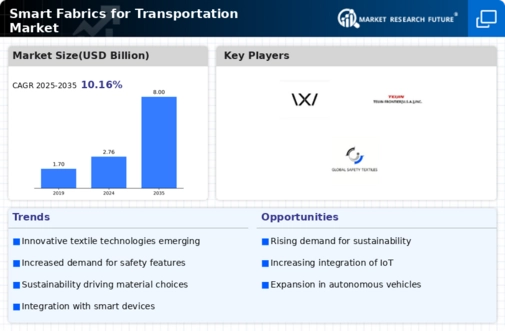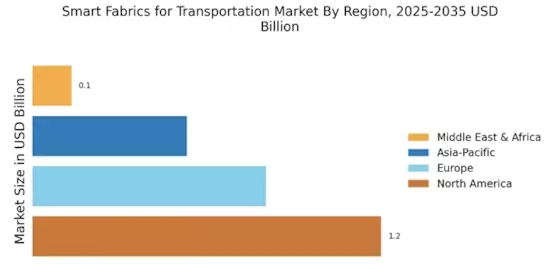Growing Focus on Fuel Efficiency
The Smart Fabrics for Transportation Market is also being driven by a growing focus on fuel efficiency. As fuel prices continue to fluctuate, transportation companies are seeking innovative solutions to reduce operational costs. Smart fabrics that can contribute to weight reduction in vehicles are gaining traction, as lighter materials can lead to improved fuel economy. For instance, the integration of smart textiles in vehicle interiors and exteriors can enhance aerodynamics and reduce overall weight. This trend is expected to propel the market forward, with projections indicating that the demand for lightweight materials in transportation could increase by 15% over the next few years.
Rising Demand for Advanced Safety Features
The Smart Fabrics for Transportation Market is experiencing a notable surge in demand for advanced safety features. As transportation systems evolve, the integration of smart fabrics that can monitor and respond to environmental conditions is becoming increasingly critical. These fabrics can provide real-time data on vehicle performance and passenger safety, potentially reducing accidents and enhancing overall safety. According to recent estimates, the market for smart textiles in transportation is projected to grow at a compound annual growth rate of over 20% in the coming years. This growth is driven by the need for innovative solutions that enhance safety and efficiency in transportation.
Technological Advancements in Fabric Manufacturing
Technological advancements in fabric manufacturing are significantly influencing the Smart Fabrics for Transportation Market. Innovations such as 3D weaving and nanotechnology are enabling the production of fabrics that are not only lightweight but also possess enhanced durability and functionality. These advancements allow for the creation of textiles that can integrate sensors and other electronic components seamlessly. As a result, manufacturers are increasingly adopting these technologies to meet the growing demand for smart fabrics in various transportation applications, including automotive and aerospace. The market is expected to witness a substantial increase in the adoption of these advanced manufacturing techniques, potentially leading to a more competitive landscape.
Consumer Demand for Customization and Personalization
Consumer demand for customization and personalization is increasingly shaping the Smart Fabrics for Transportation Market. As consumers seek unique and tailored experiences, the integration of smart fabrics that can adapt to individual preferences is becoming more prevalent. These fabrics can offer features such as temperature regulation and color change, enhancing user comfort and satisfaction. This trend is particularly evident in the automotive sector, where manufacturers are exploring ways to incorporate personalized smart textiles into vehicle interiors. The market is expected to respond positively to this demand, with forecasts suggesting a rise in the adoption of customizable smart fabrics in transportation applications.
Increased Investment in Smart Transportation Solutions
Increased investment in smart transportation solutions is a key driver for the Smart Fabrics for Transportation Market. Governments and private sectors are allocating substantial resources towards the development of intelligent transportation systems that incorporate smart fabrics. These investments are aimed at enhancing the efficiency and safety of transportation networks. For example, smart fabrics can be utilized in public transportation systems to monitor passenger flow and environmental conditions, thereby improving service delivery. The market is likely to benefit from this trend, as the total investment in smart transportation technologies is projected to reach billions of dollars in the next few years.


















Leave a Comment